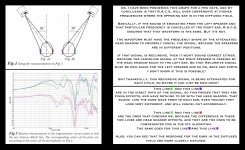Hmm.. Have to say Geneva Lab got pretty interesting style of advertisement 
An externally hosted image should be here but it was not working when we last tested it.
I don't consider diffuse field as a conflict. Conflict is where you got two or more clearly perceived spatial cues for a same sound event but they are pointing to different directions, for example.
- Elias
I still don't understand the benefit. Summing localization works for most people despite conflicting pinna cues. It's simply the limitations of stereo.
Additionally, how would you create a truly diffuse sound field above 5kHz (I guess that's the frequency range you're talking about?) in an acoustically small room?
I don't think that graph is representive enough to have any use.
I originally used the MIT Kemar data and a model by Richard O Duda to estimate head attenuation. We are dealing with attenuations ranging from a fraction of a dB to a few dBs. For example see the head model I used on the R A C E plot.
There is actually a boost on the near side, and attenuation on the far side, compared to free field conditions.
BTW. I will be away, and offline for a few days.
Well, yeah. I'm just using this graph because it's the one being discussed here.
I know we shouldn't go by this graph as a reference. I'm just running a theory by you guys.
Try here:
EarLab | Databases | Special Collections | CIPIC HRTF Search
Even then some of the differences may be 'buried in the noise'.
Thanks David! Unfortunately I don't have Matlab.
I had rather bad experience with non-individualized HRTFs in the past. They simply didn't work for me. So I'm wondering how large the individual variance is in the CIPIC data?
HRTFs are good for colouring sound..
That site privides .txt files and graphs, if you select a smalll subset.
I think the old CoolEdit used to accept ascii. It should niot be too difficult to fiind a way to convert to .wav files.
I'm not quite sure what I am looking at yet!
I'm not sure what the data in the text file represents. If it's magnitude data then I wouldn't know what frequency to assign to each line.
That would be the tabulated data for the Head Related Impulse Responses for right and left ears. ie. waveform -amplitude v time. Reading the recipe, it would seem to be with the ear canal blocked, normalised, and other caveats apply.
EarLab | Databases | Special Collections | CIPIC HRTF Data | Graph Data
That would be the tabulated data for the Head Related Impulse Responses for right and left ears. ie. waveform -amplitude v time. Reading the recipe, it would seem to be with the ear canal blocked, normalised, and other caveats apply.
EarLab | Databases | Special Collections | CIPIC HRTF Data | Graph Data
Impulse response data? Not sure how to make those text files work in measuring software like REW.
Sometimes it helps to look at things a little bit longer than only 5 seconds - the data I was looking for is already there, e.g. EarLab | Databases | Special Collections | CIPIC HRTF Data | Graph Data
Cool ! Now the only thing to figure out is which one of the subjects resembles myself
Eventually one needs to get his own head checked
- Elias
Unfortunately I don't have Matlab.
...
So I'm wondering how large the individual variance is in the CIPIC data?
Who needs Matlab when we can have Octave http://www.gnu.org/software/octave/
Someone could download number of those files (for same angles), and plot them in one figure to visually find out the variance.
- Elias
Who needs Matlab when we can have Octave Octave
Someone could download number of those files (for same angles), and plot them in one figure to visually find out the variance.
- Elias
Never played around with Octave and currently also don't have the time to do so. So, someone = you?
Cool ! Now the only thing to figure out is which one of the subjects resembles myself
Try the ugly ones first!
Eventually one needs to get his own head checked
- Elias
__________________So, someone = you?
and all those that have been playing with the wavelets thing from Elias...
__________________
and all those that have been playing with the wavelets thing from Elias...
So, not me again! Shame on me
So, not me again! Shame on me
It's never too late to learn !
BTW, have you already grasped the Blumlein stereo patent, about amplitude panning to ITD ?
It is relevant here, because when cross talk is cancelled amplitude difference to ITD conversion does not happen ! That's why Ambiophonics requires recorded low freq ITD cues. Conventional stereo triangle do not require recorded low freq ITD cues, because they are formed at the listening position due to cross talk. All the studio mixing gear include only amplitude panning, and they are suitable for stereo. Ideal Ambiophonics uses a special recording microphone to capture ITD at the recording end.
- Elias
Last edited:
It's never too late to learn !
BTW, have you already grasped the Blumlein stereo patent, about amplitude panning to ITD ?
It is relevant here, because when cross talk is cancelled amplitude difference to ITD conversion does not happen ! That's why Ambiophonics requires recorded low freq ITD cues. Conventional stereo triangle do not require recorded low freq ITD cues, because they are formed at the listening position due to cross talk. All the studio mixing gear include only amplitude panning, and they are suitable for stereo. Ideal Ambiophonics uses a special recording microphone to capture ITD at the recording end.
- Elias
Uh, conventional two-speaker stereo is not that bad after all?
- Home
- Loudspeakers
- Multi-Way
- Try Ambiophonics with your speakers
